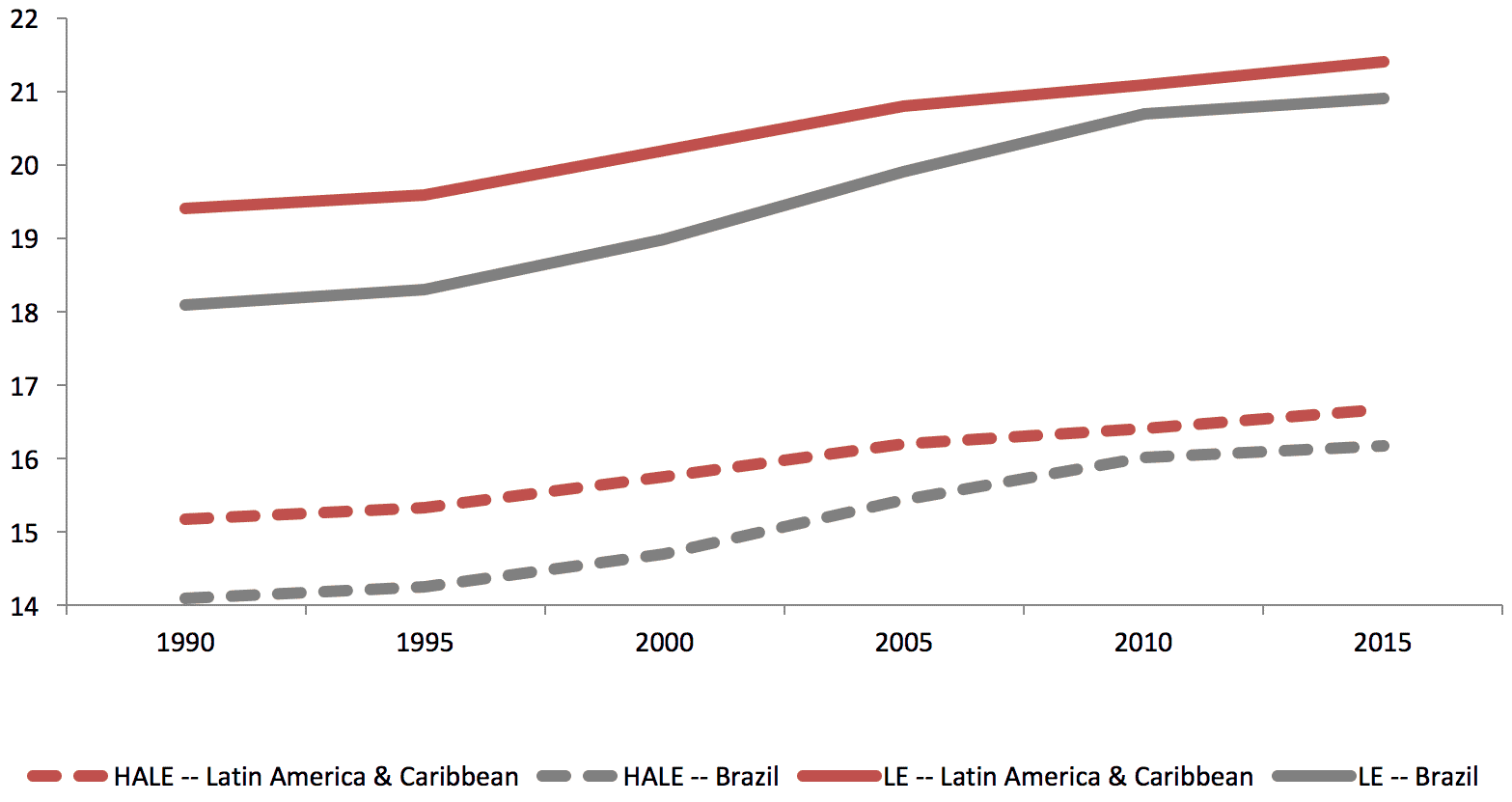Brazil only became an “aging” society in 2012, but the share of its population age 65 and older is projected to triple by 2050, driven by improved life expectancy and declining fertility rates. As Brazil’s population is still relatively young, aging has not yet become a matter of wide public interest. Over the past two elections, in 2014 and 2016, not a single major candidate for president or mayor talked specifically about older Brazilians.
Lack of attention to this looming demographic shift is clear in the government’s failure to fully implement policies that have been on the books since the 1980s to protect the rights and interests of senior citizens. However, there are positive signs in recent moves by the government, including a push to build age-friendly cities and healthcare plans oriented specifically toward older Brazilians.
The productive potential that is dormant in the older population is also under the radar of most policymakers and companies, but awareness of the economic potential of older adults is beginning to grow. This is evidenced in several recent hiring programs launched by private employers that target experienced talents. The market opportunity for digital products specifically targeting older people is also gaining traction. Private-sector interest in courting older consumers is growing, especially when it comes to digital healthcare products. The government has also played a role in developing this market by funding the development of information and communication technology products aimed at older consumers.
Brazil’s pace of aging, in terms of growth in the share of the total population, will be the fastest among all the countries in this study. By 2050, Brazil will have the world’s fourth-largest older population, behind only China, India, and the United States.
Source: UN Population Division
Number and Share of Population Age 65 or Older
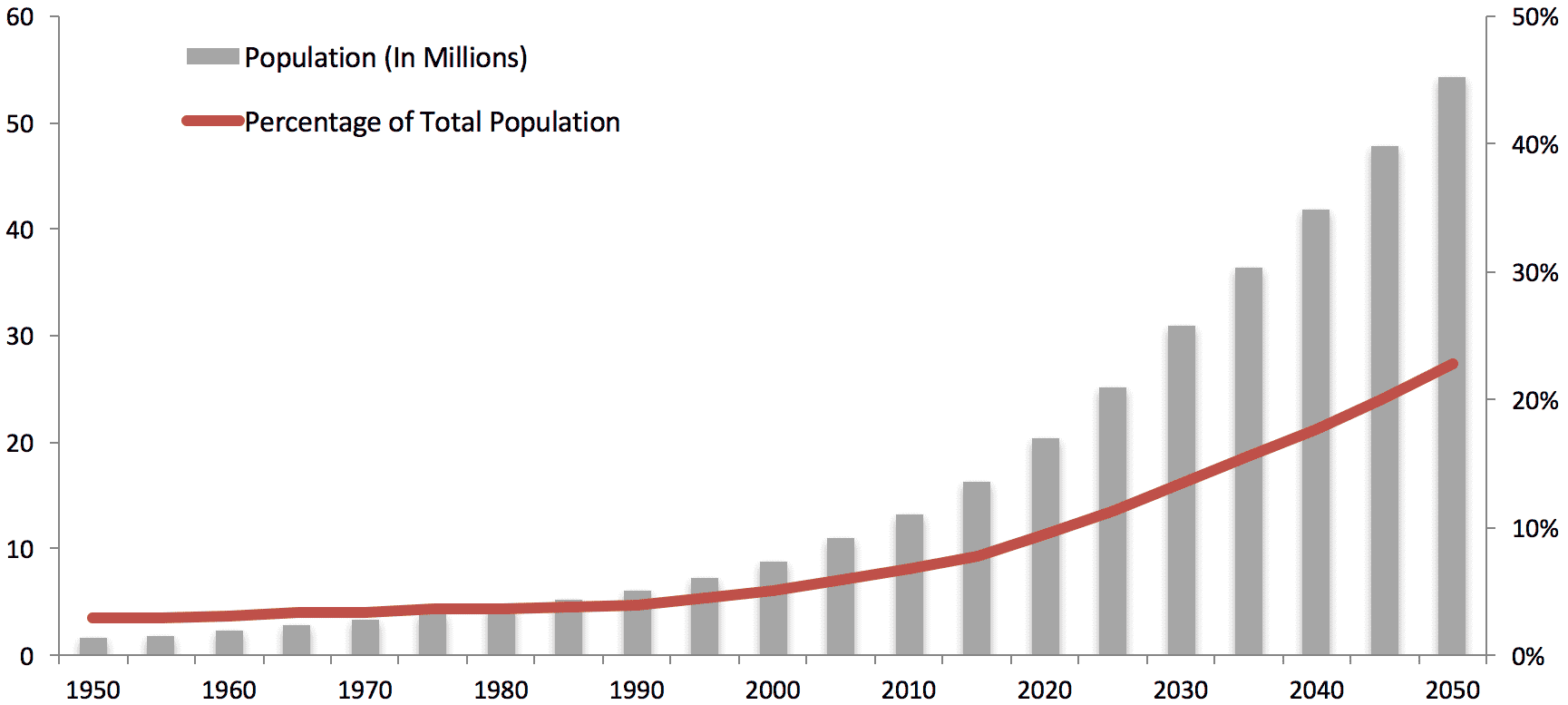
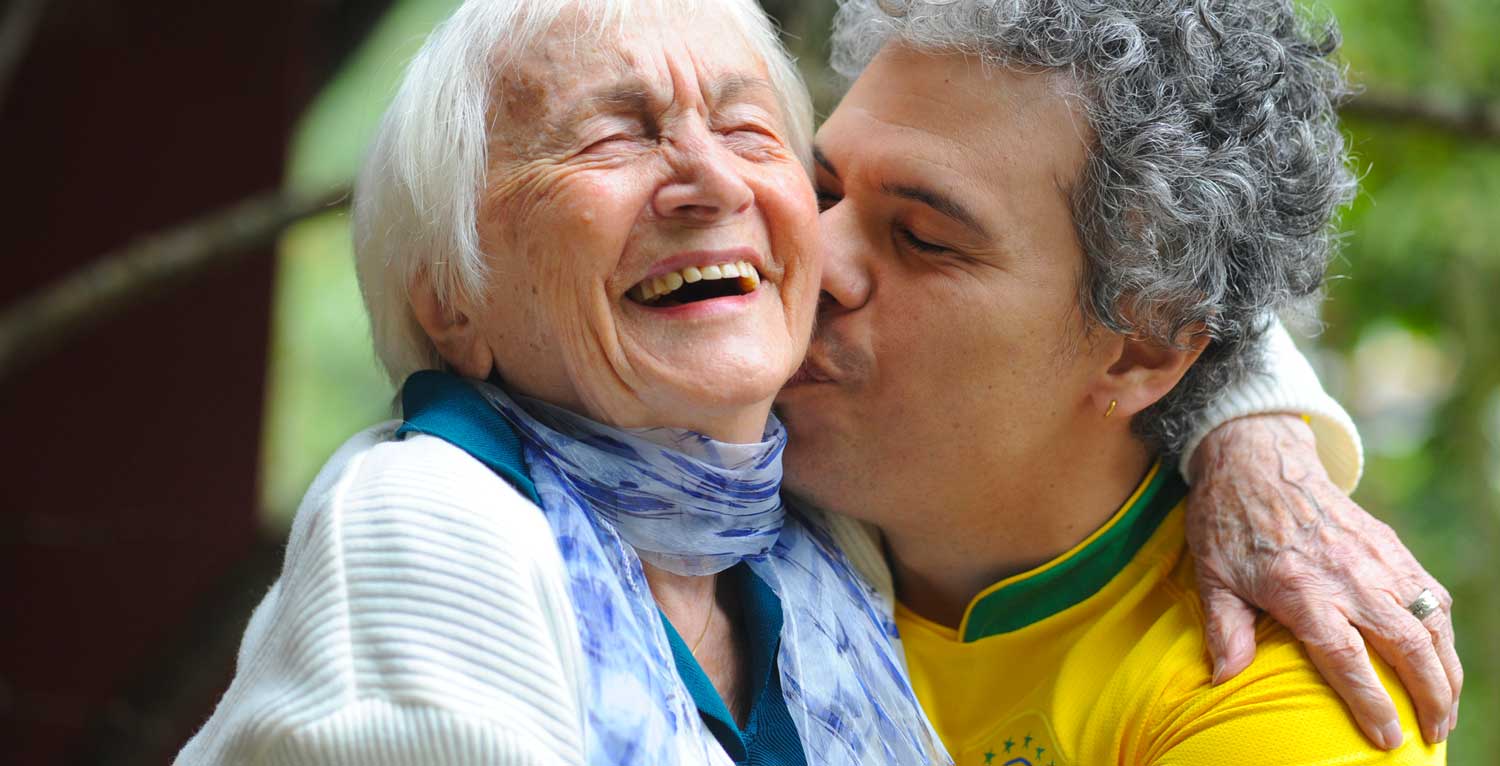
Community Social Infrastructure
With a relatively young population and other development priorities, accommodating aging has not yet become a focus of the Brazilian government. Starting in the 1980s, Brazil put in place a set of legal safeguards to protect the rights of older adults as part of its broader effort to pursue social inclusiveness, but in practice policy implementation has fallen short in areas such as transportation and housing accessibility. However, as the Brazilian population begins to age, and independence increases, support for “active aging” is gaining ground, exhibited by efforts of some local governments, like the state of São Paulo, as well as leading NGOs, to promote age-friendly cities.
“Brazil has excellent legal instruments in relation to its older population, but the law does not function as it should have. Good policies exist, but in practice the implementation is not sufficient.”
– Maria Angelica Sanchez, former President of the Gerontology Department at the Brazilian Society for Geriatrics and Gerontology
The State of São Paulo’s Initiative on Age-Friendly Cities and Communities
The state of São Paulo launched the Elder-Friendly Cities Seal in 2012 – 637 cities have already committed to the program. In order to receive full recognition as age-friendly, city governments must create a City Council for the Elderly, complete policy assessments, register all low-income older adults in the public services system and at community health centers, and take any other actions deemed appropriate by the individual city. The program is a joint effort of different state ministries that has financial backing from the State Fund for the Elderly, which receives funds from the state of São Paulo, the federal government, and city governments, as well as donations and fines collected for elder abuse. This fund, as of 2017, has more than BRL 10 million (approximately USD 3 million).
Brazil is projected to start to exit the “demographic bonus” around 2020, when the ratio of the number of people ages 0-14 and 65 and above to the number of people ages 15-64 hits an inflection point.
Source: UN Population Division
Ratio of Population Ages 0–14 and 65 or Older per 100 Population Ages 15–64
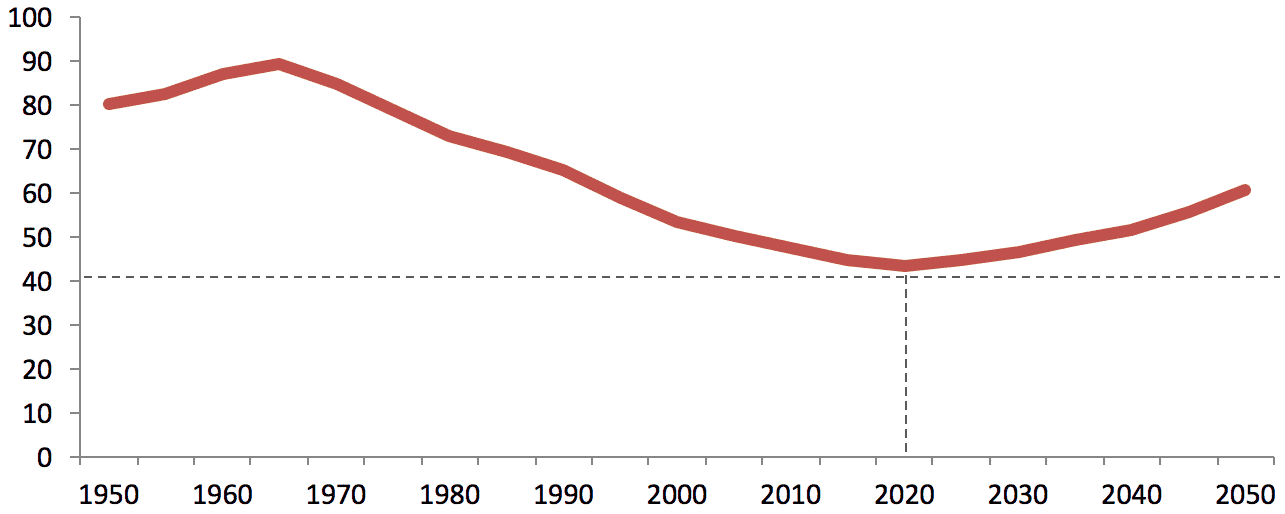
Productive Opportunity
Tapping productive opportunity among the older population is not a priority for the Brazilian government, which has focused on addressing immediate development issues, such as poverty, inequality, and credit booms. Social welfare programs have used direct cash payments as the primary tool to support vulnerable groups, creating a disincentive for labor force participation. Looking ahead, the government has pledged to undertake potential reform as part of its efforts to pursue long-term fiscal sustainability, but it has attracted widespread opposition.
The participation of people age 65 and older in the labor force fell by nearly two-thirds in Brazil, from 60 percent in the 1970s to 21 percent in 2014, mainly due to access to public pensions, social benefits, and increased payouts.
With a large working-age population, the government has done little to improve market conditions for older jobseekers. However, an increasing number of initiatives have been launched by non-governmental entities over the past few years, demonstrating a rising societal awareness of the value of older workers.
Expanding Productive Opportunity
Dotz, a company that provides benefits for customers along with the purchases they make, was inspired by the Robert de Niro movie The Intern and decided to create a technology manager position aimed at candidates over age 55 at the end of 2015. It received more than 1,500 résumés and hired three applicants. The program has been such a success, with both the new and old employees learning from one another, that the president of Dotz is considering a second round of hires.

Technological Engagement
Interest in the older-age market is growing in the Brazilian technology sector, as some local companies, led by startups, have begun to develop products using information and communication technology (ICT) to meet the needs of older adults and their families. The government has also increased funding for innovations that assist with independent living of older adults and people with disabilities. However, the digital divide between older adults and the rest of the population and limited support for digital literacy remain barriers to fully unleashing this promising market.
“Living Without Limits” Program
The Brazilian government launched a national plan in 2011 called “Living Without Limits" which aims to promote new initiatives for Brazilians with disabilities, including older people. Of those 65 and older, 67.6 percent have some disability. One arm of this plan is the Program for Innovation in Assistive Technology, which has provided more than BRL 175 million (approximately USD 54 million) in funding. Funds are provided to winners of public contests, mainly in the forms of reimbursable credit for Brazilian companies and non-reimbursable funding for universities and research institutes. In its latest public contest, which took place in 2015 and 2016, 14 out of 270 entries received funding, with individual awards ranging from BRL 690,000 (USD 211,000) to BRL 3.8 million (approximately USD 1.2 million). One of the winning entries was the Virtual Assistant for Social Inclusion and Autonomy, a cellular application for those with visual disabilities, which has reached the commercial market and had had 28,000 downloads as of January of 2017.
Only 16 percent of respondents age 60 and older in a 2015 survey had used the Internet in the previous three months, compared with 58 percent for respondents of all age groups. Lack of interest is the top reason cited by three-quarters of the older respondents who had never used the Internet.
Source: The Center of Studies on Information and Communication Technologies
Percentage of People Using Digital Technology Over the Last Three Months (2015)
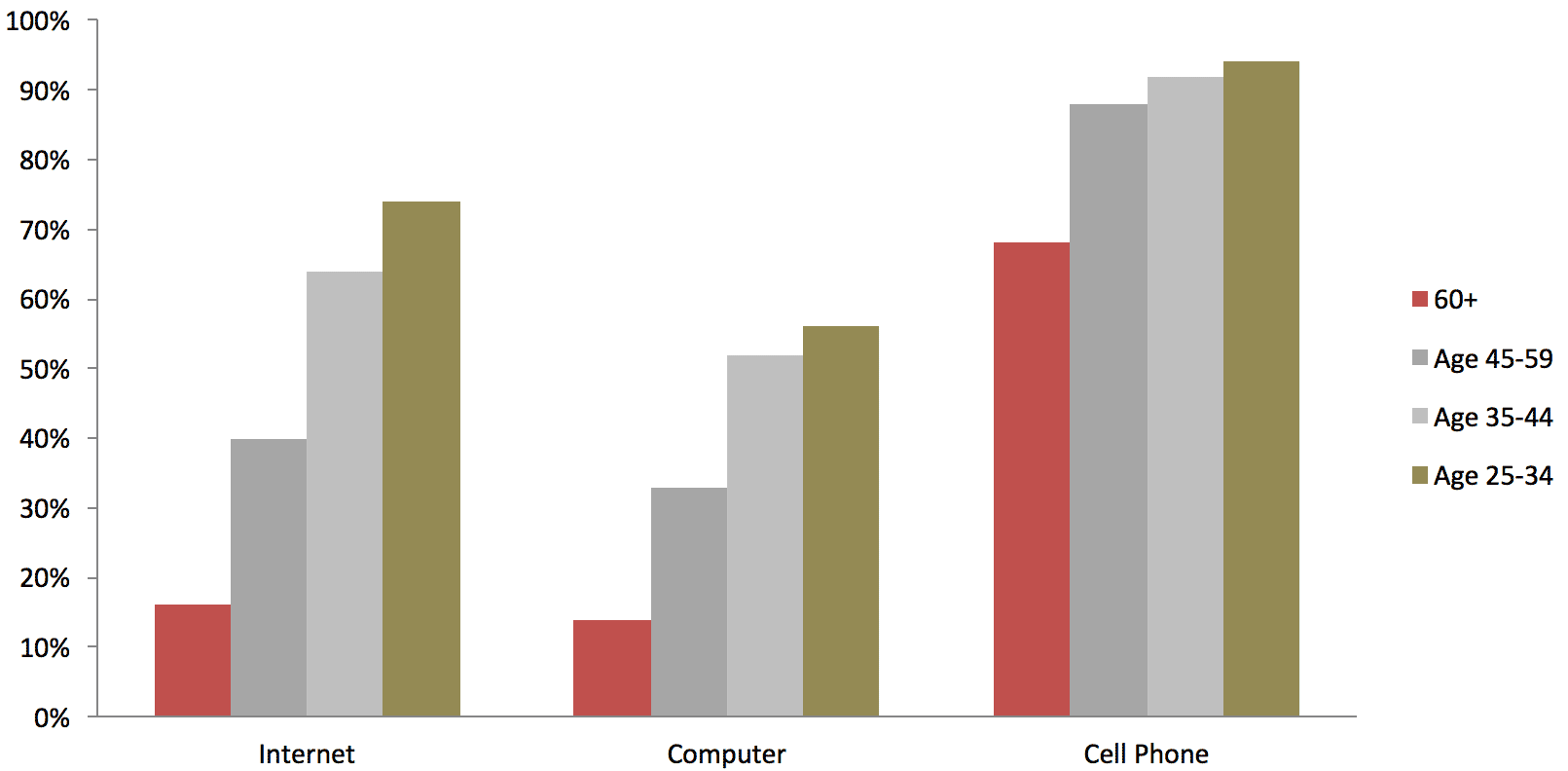
Healthcare & Wellness
Although below the regional average, the longevity and healthy life expectancy of Brazilians have increased significantly over the past decade, partly thanks to the improvements in the country’s healthcare system. By introducing a dual healthcare system in 1988, Brazil guaranteed the right to free healthcare for all citizens through the Unified Health System (SUS) and allowed for the parallel existence of a private healthcare system. However, major gaps exist when it comes to older citizens in both medical and long-term care. To address this, the government is working to address the needs of older patients while also improving the broader Brazilian healthcare system.
Well-Cared-For Elderly Project (Projeto Idoso Bem Cuidado)
The National Agency of Supplementary Health (ANS) launched a pilot called the “Well-Cared-For Elderly Project” in 2016. It aims to create a model for the provision of care to older adults who have private health plans, who tend to be wealthier but also have greater demands for healthcare. Currently, there are no general practitioners for primary care whom older patients could see to monitor medications, forcing them to use emergency care or hospitalization or to go directly to specialists. Under this new model, a doctor and a nurse become the primary points of reference, and they refer patients to specialists and organize their healthcare. The ANS also hopes that this can serve as a more efficient model of private healthcare in general, perhaps leading to advances for other parts of the Brazilian healthcare system. Private healthcare operators and service providers may voluntarily participate in the project. Almost 70 healthcare institutions are already participating, and there has been a noticeable drop in visits to specialists.
Lifespan of Brazilians ages 60 through 64 increased by 2.8 years from 1990 through 2015. At the same time, healthspan of the same age group increased by 2.1 years. Improving at a faster rate than their Latin American and Caribbean counterparts, Brazil is steadily closing the gap with the regional average.
Source: Institute for Health Metrics and Evaluation
Healthy Life Expectancy (HALE) and Life Expectancy (LE) at Ages 60–64, in Years
